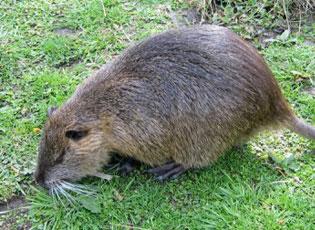Myocastor coypus Molina (ITIS)
Nutria, coypu, coypu rat, nutria rat, swamp beaver
South America (Jojola et al. 2005)
First established populations introduced in the 1930s (Jojola et al. 2005)
Introduced for fur production (Jojola et al. 2005)
Damages vegetation and destroys habitat in wetlands (Jojola et al. 2005)
Gulf of Mexico coast, Atlantic coast, Pacific Northwest

Nutria
Photo by Justin Secrist
Find more images
Spotlights
Distribution / Maps / Survey Status
Videos
All Resources
Selected Resources
The section below contains highly relevant resources for this species, organized by source.
Council or Task Force
Partnership
Federal Government
International Government
State and Local Government
Integrated Taxonomic Information System. Myocastor coypus. [Accessed Sep 21, 2023].
Jojola, S., G. Witmer, and D. Nolte. 2005. Nutria: an invasive rodent pest or valued resource? In: D.L. Nolte and K.A. Fagerstone (Eds.), Proceedings of the 11th Wildlife Damage Management Conference (Paper 110). Fort Collins, Colo.: National Wildlife Research Center.
